| |
|
Xiamen Oil Paintings, Wholesale Direct!
|
|
100% hand painted, 100% cotton canvas, 100% money back if not satisfaction. |
|
|
|
|
ART WORKS INDEX
A
B
C
D
E
F
G
H
I
J
K
L
M
N
O
P
Q
R
S
T
U
V
W
X
Y
Z
|
|
ARTISTS INDEX
A
B
C
D
E
F
G
H
I
J
K
L
M
N
O
P
Q
R
S
T
U
V
W
X
Y
Z
|
|
|
|
 |
Kapiton Zelentsov
|
|
Kapiton Zelentsov (Russian 1790-1845) was a Russian painter notable for his illustrations for books by Aleksandr Pushkin, Faddei Bulgarin and Mikhail Zagoskin. He was the student of Alexey Venetsianov.
|
|
 |
Kane Paul
|
|
Irish-born Canadian Painter
b.1810 d.1871
was an Irish-Canadian painter, famous for his paintings of First Nations peoples in the Canadian West and other Native Americans in the Oregon Country. A largely self-educated artist, Kane grew up in Toronto (then known as York) and trained himself by copying European masters on a study trip through Europe. He undertook two voyages through the wild Canadian northwest in 1845 and from 1846 to 1848. The first trip took him from Toronto to Sault Ste. Marie and back. Having secured the support of the Hudson's Bay Company, he set out on a second, much longer voyage from Toronto across the Rocky Mountains to Fort Vancouver and Fort Victoria in the Columbia District, as the Canadians called the Oregon Country. On both trips Kane sketched and painted Aboriginal peoples and documented their lives. Upon his return to Toronto, he produced more than one hundred oil paintings from these sketches. Kane's work, particularly his field sketches, are still a valuable resource for ethnologists.
|
|
|
|
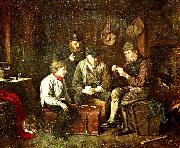 |
k. e. jansson
|
|
Karl Emanuel Jansson, född 7 juli 1846 i Finström, Åland, död 1 juni 1874 i Jomala, var en åländsk konstnär. Han var näst äldst av sju syskon. Han far, Jan Jansson, var en bonde i Pålsböle.
Sina konstnärliga inspiration fick han av sockenmålaren G Kjellgren, vid sex-sju års ålder, när han där lärde sig att läsa och skriva. Efter avlutad skolgång sattes han i skomakarlära. Efter ett år drogs han till Kjellgren och fungerade som hans hjälpreda. Kyrkoherden Frans von Knorring såg i slutet av 1859 några av hans teckningar. Han sände några till Finska Konstföreningens direktion och lovordade Karl.
Förening gav ett bidrag för att kunna studera vid Finska Konstföreningens ritskola i Åbo, under ledning av Robert Wilhelm Ekman. Av Ekman fick han husrum, rit- och målningsmaterial och en hel del extra undervisning. Karl gjorde stora framsteg under de 2 åren han målade med Ekman.
Jansson flyttade hösten 1862 till Stockholm, för att kunna utvecklas mer som artist, och inskrevs som elev vid Kongl. Akademin för de fria konsterna. Han tog anatomiexamen 1863. Han levde under svåra ekonomiska förhållanden och hade svårt att sälja sina verk.
Jansson fick hård kritik för de målningar han sände hem, exempelvis, Babian ätande en råtta, och konstföreningen betraktade dem med avsky. Han började då kritisera sig själv allt mer och mer, och den inställningen behöll han. Han fick inte den uppmärksammad han behövde. Tavlan Den förlorade sonens återkomst, belönades med ett pris. Han avslutade sin utbildning vid akademien 1867 med mycket beröm. Jansson lyckades utverka statsstöd för studier i Dusseldorf och reste dit på hösten 1868. Han åkte hem igen sommaren 1870 och tillbringade ett år på Åland innan han återvände till Dusseldorf.
Han var nu märkt av en tilltagande lungsjukdom. De sista verk han fullbordade var Talmannen och En slant i håven. För att lindra sin sjukdom reste han till Rom i mars 1872. Efter några månader åkte han runt till olika kurorter (Davos, Meran) men inget förbättrade hans tillstånd. Efter en liten tid i D??sseldorf kom han hem till Åland sensommaren 1873.
Karl flyttade in på Jomala gård, där lagman Lönnblad och hans fru tog hand om honom. Han målade några verk, vilka blev ofullbordade. På dödsbädden fick han veta att han belönats på världsutställningen i Wien för sina konstverk Klöveress och Talmannen, samt att han blivit medlem i konstakademin i Sankt Petersburg. Han dog 1 juni 1874, inte ens fylld 28 år.
|
|
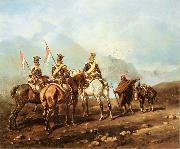 |
Juliusz Kossak
|
|
(Nowy Wiśnicz, 15 December 1824 - 3 February 1899, Krakew) was a Polish historical painter and master illustrator who specialized in battle scenes, military portraits and horses. He was the progenitor of an artistic family that spanned four generations. father of painter Wojciech Kossak and grandfather of painter Jerzy Kossak.
Juliusz Kossak grew up in Lwew during the military partitions of Poland. He obtained a degree in law at the Lwew University encouraged by his mother. At the same time he studied painting with Jan Maszkowski and Piotr Michałowski. Beginning in 1844 Kossak worked on commissions for the local aristocracy in Malopolska, Podolia and Wolyn. He married Zofia Gałczyka in 1855 and together they left for Paris where they spent five years. His sons were born there, the twin brothers: Wojciech and Tadeusz (on New Year's Eve 1856-1857) and the younger Stefan in 1858. The family came to Warsaw in 1860 where Kossak obtained a position as the head illustrator and engraver for Tygodnik Illustrowany magazine. They moved to Munich for a year and in 1868 settled in Krakew blessed with five children already. Kossak bought a small estate there, known as Kossakewka, famed for artistic and literary salon frequented by Adam Asnyk, Henryk Sienkiewicz, Stanisław Witkiewicz, Jezef Chełmoki and many others. Juliusz Kossak lived and worked there till the end of his life. In 1880 he was awarded the Cross of Order of Merit by Emperor Franz Joseph of Austria-Hungary for his lifetime achievements as an artist.
|
|
 |
Julius Kronberg
|
|
1850-1921,Swedish painter and illustrator. He was educated at the Konstakademi in Stockholm, where his teachers were J. C. Boklund (1817-80), August Malmstr?m and Johan Fredrik H?ckert. In 1873 he travelled on a scholarship to D?sseldorf, and in the following year he went to Munich. There he was strongly influenced by the Old Masters (especially Rubens), as well as Hans Makart robustly theatrical style. Together they shaped Kronberg early works, for example Hunting Nymph and Fauns (1875; Stockholm, Nmus.), which caused a sensation when it was exhibited in Stockholm in 1876 and established his reputation. Kronberg left Munich in 1877 and settled in Rome, where, between trips to Egypt and Tunisia, he stayed until 1889, when he returned to Stockholm. During his years in Rome his style became increasingly austere. His exuberant Munich manner was replaced by a colder illusionism, which emphasized the historical details of subjects taken from the Bible and Shakespeare. Typical is David and Saul (1885; Stockholm, Nmus.), which reflected his study of Lawrence Alma-Tadema.
|
|
|
|
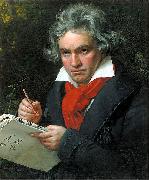 |
Joseph Karl Stieler
|
|
(1 November 1781 - 9 April 1858) was a German painter. Born in Mainz to a family of engravers and die-cutters, Stieler received some artistic training from his father, August Friedrich Stieler (1736 - 1789). Stieler began his career as a painter of miniatures.
His portrait style was most especially shaped during his work in the Parisian atelier of Francois Gerard, a student of Jacques-Louis David. In 1808, he established himself as an independent portraitist in Frankfurt am Main. He traveled through Italy in 1810. In 1816, he traveled to Vienna to paint the portrait of Emperor Francis I of Austria. Between February and April 1820, he worked on his portrait of Beethoven, which is probably the most well-known representation of the composer today.
Stieler worked mainly in the service of the Bavarian court. His painted likenesses in Schloss Nymphenburg, Schönheitengalerie, the so-called Gallery of Beauties, were commissioned by King Ludwig I. Stieler also painted the portraits of Goethe, Amalia of Greece, Friedrich Wilhelm Joseph von Schelling, Johann Ludwig Tieck, and Alexander von Humboldt.
The most distinguishing feature of Stieler's portraits is his utter focus on the sitter. Decorative additions are left out, and there is nothing that distracts the viewer's scrutiny. Stieler accomplished this concentration through deliberate light - dark contrast, which above all highlights the accurately characterized facial features.
He died in Loytown.
|
|
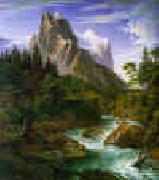 |
Joseph Anton Koch
|
|
1768-1839
Austrian
Joseph Anton Koch Galleries
was an Austrian painter of the German Romantic movement. The Tyrolese painter left academic training in the Karlsschule Stuttgart, a strict military academy, and traveled through France and Switzerland. He arrived in Rome in 1795. Koch was close to the painter Asmus Jacob Carstens and carried on Carstens' 'heroic' art, at first in a literal manner.
After 1800 Koch developed as a landscape painter. In Rome he espoused a new type of 'heroic' landscape, revising the classical compositions of Poussin and Lorrain with a more rugged, mountainous scenery. He left Rome in 1812 and stayed in Vienna until 1815, in protest of the French invasion. During this period he incorporated more non-classical themes in his work. In Vienna he was influenced by Friedrich Schlegel and enthusiasts of old German art. In response, his style became harsher, and this new approach had a wide influence on German landscape painters who visited Rome.
|
|
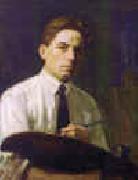 |
Joseph A Kleitsch
|
|
1885-1931
Joseph Kleitsch (1885-1931) was an American painter who holds a high place in the early California School of Impressionism. Born in Banad, Hungary on June 6th, 1885, young Joseph Kleitsch was drawn to paint at the early age of seven, he later pursued his professional art training at Budapest, Munich and Paris. Influenced by his visits to the famous museums of Europe, Kleitsch continued with his love of portrait and figuritive painting after relocating to California. There he rose to the challenge of capturing his new environment's brilliant light and diverse landscape. Living in Los Angeles for a while, Kleitsch fell in love with the rustic artist village of Laguna Beach. There he painted the town's eucalyptus lined streets, the crashing waves of the Pacific coastline and the nearby Mission San Juan Capistrano. Arthur Millier of the Los Angeles Times in 1922 was quoted saying of Kleitsch "he was a born colorist; he seemed to play on canvas with the abandon of a gypsy violinist". Joseph Kleitsch died at the age of forty-nine in Santa Ana, California on November 16th, 1931.
|
|
|
|
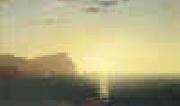 |
John Kensett
|
|
1816-1872
John Kensett Art Galleries
Artist John Frederick Kensett was born on March 22, 1816 in Cheshire, Connecticut, and died on December 14, 1872 in New York City. He attended school at Cheshire Academy, and studied engraving with his immigrant father, Thomas Kensett, and later with his uncle, Alfred Dagget. He worked as engraver in the New Haven area until about 1838, after which he went to work as a bank note engraver in New York City.
In 1840, along with Asher Durand and John William Casilear, Kensett traveled to Europe in order to study painting. There he met and traveled with Benjamin Champney. The two sketched and painted throughout Europe, refining their talents. During this period, Kensett developed an appreciation and affinity for 17th century Dutch landscape painting. Kensett and Champney returned to the United States in 1847.
After establishing his studio and settling in New York, Kensett traveled extensively throughout the Northeast and the Colorado Rockies as well as making several trips back to Europe.
Kensett is best known for his landscape of upstate New York and New England and seascapes of coastal New Jersey, Long Island and New England. He is most closely associated with the so-called "second generation" of the Hudson River School. Along with Sanford Robinson Gifford, Fitz Hugh Lane, Jasper Francis Cropsey, Martin Johnson Heade and others, the works of the "Luminists," as they came to be known, were characterized by unselfconscious, nearly invisible brushstrokes used to convey the qualities and effects of atmospheric light. It could be considered the spiritual, if not stylistic, cousin to Impressionism. Such spiritualism stemmed from Transcendentalist philosophies of sublime nature and contemplation bringing one closer to a spiritual truth.
In 1851 Kensett painted a monumental canvas of Mount Washington that has become an icon of White Mountain art. Mount Washington from the Valley of Conway was purchased by the American Art Union, made into an engraving by James Smillie, and distributed to 13,000 Art Union subscribers throughout the country. Other artists painted copies of this scene from the print. Currier and Ives published a similar print in about 1860. This single painting by Kensett helped to popularize the White Mountain region of New Hampshire.
Kensett's style evolved gradually, from the traditional Hudson River School manner in the 1850s into the more refined Luminist style in his later years. By the early 1870s Kensett was spending considerable time at his home on Contentment Island, on Long Island Sound near Darien, Connecticut.
|
|
|
|
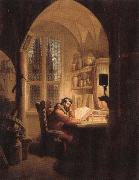 |
john keats
|
|
Born: 31 October 1795
Birthplace: Near London, England
Died: 23 February 1821 (tuberculosis)
Best Known As: Romantic poet who wrote "Ode to a Nightingale"
|
|
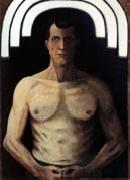 |
John Kane
|
|
1860-1934
American painter of Scottish birth. In 1879 Kane emigrated to western Pennsylvania. He worked as a bricklayer, coal miner, steel worker and carpenter in the Ohio River valley and, in 1890, began to sketch local scenery. After losing his leg in a train accident in 1891, he was employed painting railway carriages. When his son died in 1904, Kane left his family and spent years wandering and working in odd jobs; his earliest surviving paintings date from around 1910. Settling in Pittsburgh, he worked as a house painter and in his spare time painted portraits, religious subjects, the city's urban landscape and memories of his Scottish childhood. In 1927 the jury of the Carnegie International Exhibition, Pittsburgh, encouraged by the painter-juror Andrew Dasburg (b 1887), accepted Kane's Scene in the Scottish Highlands (1927; Pittsburgh, PA, Carnegie Mus. A.). Kane's success, at first considered a hoax by the press, was based on the modernist interest in primitive and folk art. His work was regarded as non-academic and boldly original, and he became the first contemporary American folk artist to be recognized by a museum. Larimer Avenue Bridge (1932; Pittsburgh, PA, Carnegie Mus. A.) is characteristic of his style with its meticulous detail, flat colour and dominant green and red. Though he sketched and painted on the site, Kane freely transposed pictorial elements to create a more pleasing composition. This innate compositional sense is evident in his Self-portrait (1929; New York, MOMA).
|
|
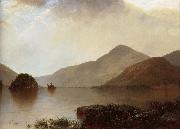 |
John Frederick Kensett
|
|
American Hudson River School Painter, 1816-1872
He attended school at Cheshire Academy, and studied engraving with his immigrant father, Thomas Kensett, and later with his uncle, Alfred Dagget. He worked as engraver in the New Haven area until about 1838, after which he went to work as a bank note engraver in New York City. In 1840, along with Asher Durand and John William Casilear, Kensett traveled to Europe in order to study painting. There he met and traveled with Benjamin Champney. The two sketched and painted throughout Europe, refining their talents. During this period, Kensett developed an appreciation and affinity for 17th century Dutch landscape painting. Kensett and Champney returned to the United States in 1847. After establishing his studio and settling in New York, Kensett traveled extensively throughout the Northeast and the Colorado Rockies as well as making several trips back to Europe. Kensett is best known for his landscape of upstate New York and New England and seascapes of coastal New Jersey, Long Island and New England. He is most closely associated with the so-called "second generation" of the Hudson River School. Along with Sanford Robinson Gifford, Fitz Hugh Lane, Jasper Francis Cropsey, Martin Johnson Heade and others, the works of the "Luminists," as they came to be known, were characterized by unselfconscious, nearly invisible brushstrokes used to convey the qualities and effects of atmospheric light. It could be considered the spiritual, if not stylistic, cousin to Impressionism. Such spiritualism stemmed from Transcendentalist philosophies of sublime nature and contemplation bringing one closer to a spiritual truth.
|
|
 |
Johann Peter Krafft
|
|
(15 September 1780 - 28 October 1856) was a German-Austrian painter.
Krafft was born in Hanau, Hesse. At the age of ten, he began his art studies at the Hanau Akademie. In 1799, he moved to Vienna and studied at the Academy of Fine Arts for three years under the tutelage of Heinrich Feger. From 1802 to 1808, he studied in Paris, with Jacques-Louis David and François Gerard, and then in Rome. On his return to Vienna, he became a successful professional painter, producing numerous portraits.
In 1828, Krafft became director of the Imperial and Royal Picture Gallery in Belvedere Palace.
Johann Peter Krafft died at the age of 76 in Vienna, where he was buried at the Zentralfriedhof.
|
|
|
|
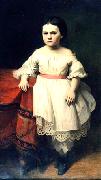 |
Johann Koler
|
|
(8 March 1826, in Vastemõisa near Suure-Jaani, Viljandi County, Estonia - 22 April 1899 in St. Petersburg, Russia) was an Estonian painter. He is considered to have been the first professional Estonian painter. He distinguished himself primarily by his portraiture and to a lesser extent by his landscape paintings. Some of his most notable pictures depict the Estonian rural life in the second half of the 19th Century.
Johann Köler was the seventh child born to a peasant family. Despite the poverty of the parents Köler managed to attend the elementary and the district schools in Viljandi. Then he attended a workshop of master painters in Cesis (then in Livonia).
In 1846, Köler travelled to St. Petersburg to work as a sign writer, where his talent was soon discovered. From 1848 to 1855 Johan Köler studied drawing and painting at the St. Petersburg Imperial Academy of Arts.
During 1857 Köler travelled to Paris via Berlin, later returned to Germany then travelled to the Netherlands and Belgium. In 1858, he travelled across the Alps to Milan, Geneva, Florence and Rome. There, he studied in a private academy and devoted his time to watercolor technique. In Rome during 1859 he presented his composition "Christ on the Cross".
Answering the call of the St. Petersburg Academy of Arts, Köler returned to the city in 1861. From 1862 to 1874 he was a teacher of the Grand Duchess Maria Aleksandrovna, the daughter of Czar Alexander II of Russia. In 1869-1870, he worked as a lecturer at the St. Petersburg Academy of Arts. From 1886 to 1889 Johan Köler worked in Vienna, Nice and Paris.
|
|
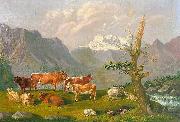 |
Johann Kaspar Scherrer
|
|
painted Weidelandschaft in den Schweizer Bergen mit Katarakt und Gebirgshorizont in 1739 - 1806
|
|
|
|
|
|
 |
johan krouthen
|
|
född 2 november 1858, död i december 1932, var en svensk idealistisk konstnär.
Krouthen föddes i Linköping och var son till handlaren Conrad Krouthen och Hilda Åberg. Släkten Krouthen kom från Norrköping och flera generationer hade arbetat som tenngjutare. Familjenamnet Krut ändrades genom att varubeteckningen Krut-tenn förfranskades till Krouthen. Conrad Krouthen kom till Linköping 1850 och startade en manufakturaffär vid Stora torget. Affären gick bra och 1857 kunde han gifta sig med sömmerskan Hilda Åberg.
Krouthen kunde växa upp i ett välmående hem och han fick börja skolan på läroverket i Linköping. Vid 14 års ålder slutade han skolan och började arbeta åt fotografen och målaren Svante Leonard Rydholm som hade en atelje vid St. Larsplan. Krouthen fick lära sig grunderna i både målning och fotografering och vid 16 års ålder började han på Konstakademiens principskola i Stockholm 1875. Den treåriga utbildningen innebar att eleverna fick lära sig att rita av klot och profiler, djur och växter. Efter de tre åren fick Krouthen fortsätta vid akademin. I kursen "Lägre antiken" fick eleverna rita av gipsmodeller, i "Högre antiken" teckna efter levande model och i "Landskapsskolan" fick eleverna måla landskap. Under studietiden sökte sig många elever utanför skolan och Krouthen lärde känna konstnären Edvard Perseus. Perseus var kritisk till utbildningen på akademin och tog med sina elever bland annat till Mariefred och Gripsholms slott för att måla av naturen.
|
|
|
|
 |
Jessie Marion King
|
|
1875-1949,was a Scottish painter and illustrator of Children's books. She was married to E. A. Taylor. She was born in Bearsden, near Glasgow. Her father was a minister with the Church of Scotland and she received a strict religious education and was discouraged from becoming an artist. Jessie M. King began training as an Art teacher in 1891 at Queen Margaret??s College. In 1892 she entered the Glasgow School of Art. As a student, she received a number of awards, including her first silver medal from the National Competition, South Kensington (1898). King was made Tutor in Book Decoration and Design at Glasgow School of Art in 1899. Her first published designs, and some people believe her finest, were for the covers of books published by Globus Verlag, Berlin between 1899 and 1902. The publisher was a subsidiary company of the great Berlin department store, Wertheim's. She was influenced by the Art Nouveau of the period and her works juxtaposed in mood with that of The Glasgow Four. She made a Grand Tour of Germany and Italy in 1902 and was influenced by the works of Botticelli. In the same year her binding for "L'Evangile de L'Enfance" was awarded a gold medal in the International Exhibition of Modern Decorative Art, held in Turin. King became a committee member of the Glasgow Society of Artists (1903) and a member of the Glasgow Society of Lady Artists (1905). Her contribution to Art Nouveau peaked during her first exhibitions, Annan's Gallery in Glasgow (1907) and Bruton Street Galleries, London (1905). She married E. A. Taylor in 1907 and moved with him to Salford. In 1910 they moved on to Paris where Taylor had gained a professorship at Tudor Hart's Studios.
|
|
|
|
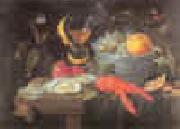 |
Jan Van Kessel
|
|
1626-1679
Dutch
Jan Van Kessel Gallery
Dutch painter and draughtsman. He was a follower, and probably a pupil, of Jacob van Ruisdael and covered the same range of subjects painted by Ruisdael, with the exception of marine paintings. However, van Kessel is best known for his townscapes and panoramic views, as exemplified by the Sluice and the New City Ramparts of Amsterdam in Winter (Amsterdam, Hist. Mus.) and the Bleaching Grounds near Haarlem (Brussels, Mus. A. Anc.). He imitated the water-mills and village scenes of his friend Meindert Hobbema, as well as the waterfalls of Allaert van Everdingen, the wooded landscapes of Jan Wijnants and the winter scenes of Jan van de Cappelle. Many of van Kessel's 120 surviving pictures, including The Avenue (Stuttgart, Staatsgal.) and the Ford in the Woods (Dresden, Gem?ldegal. Alte Meister), were once attributed to van Ruisdael and these other masters (often with an authentic signature covered by the better-known name). Van Kessel is also frequently confused with other minor artists in van Ruisdael's circle, especially Jan Vermeer van Haarlem the younger, Isaac Koene (1637/40-1713), Jacob Salomonsz. van Ruysdael (1629/30-1681) and Anthonie van Borssom. As a draughtsman, van Kessel emulated van Ruisdael's mature style, working almost exclusively in black chalk and grey wash. The best of his 70 drawings are townscapes, although his studies of trees and depictions of farmsteads are noteworthy. A number of correlations exist between his sketches and paintings. There is no known relationship with the Flemish artists of the same name.
|
|
 |
Jan Kupecky
|
|
(in German: Johann Kupetzky, in Hungarian: Kupecky Jenos, or Kupeczky Jenos, 1667, Bazin, Royal Hungary (today Slovakia) - 1740, Nernberg, Germany) was a Czech and Slovak portrait painter during the baroque. He was active in Hungary, Slovakia, Vienna and Nernberg.
Kupecký, like many people at that time, was the son of Protestant (Czech Brethren) parents from the Czech lands (Mlade Boleslav) who sought refuge in Slovakia (constituting the core of Royal Hungary at that time) from religious persecution by the Catholics. He was born in Pezinok - a town near Bratislava.
According to the sources he began his studies with the Swiss painter Benedikt Klaus, who was active in both Vienna and in Royal Hungary. At the age of twenty, Kupecký went on a long Italian study trip. In Rome Prince Aleksander Benedykt Sobieski, the son of the Polish king John III Sobieski, helped him to become famous. He returned to Vienna in 1709, after twenty-two years spent in Venice and Rome. We know very little of his Italian activity as well as his early works and his setting in Vienna.
According to his contemporary biographer, the Swiss Johann Caspar Fessli, the Protestant Kupecký, who faithfully clung to his ancestor's religion, remained withdrawn and isolated in Vienna's Catholic milieu, which was under the influence of the court and the aristocracy. However this concept is partly contradicted by the fact that the master had significant courtly commissions while working in Vienna. He painted portraits of various members of the dynasty, Prince Eugene of Savoy, several aristocrats, and, in Karlovy Vary, even of the Russian Czar Peter I. The rich ceuvre of this period comprises a series of gorgeous portraits of Kupecky's family, friends and the painter himself, as well as several persons, whose identity in unknown.
In 1733 Kupecký, fearing religious persecution, fled from Vienna to Nernberg with his family and worked there until his death in 1740. As the most significant portrait painter of contemporary Germany, he was commissioned by a large number of German princes, church dignitaries rich merchants and scholars, and his works were popularized by engravings even during his lifetime. Through his pupils and followers Kupecký's influence and artistic example remained alive and widespread for a long time.
|
|
 |
Jan Kobell
|
|
(born Delfshaven, 1779; died Amsterdam, 14 September 1814) was a Dutch animal and landscape painter.
He was a pupil of Willem Rutgaart van der Wall at Utrecht. He studied diligently from nature, and took Paul Potter for his model, acquiring his talent for animal as well as landscape work. In 1812 he went to Paris, where he won the gold medal and high praise from art critics. His popularity increased rapidly until his premature death. Of his cattle pieces, noted for their technique and precision of drawing, there are excellent specimens in the museums of Amsterdam and Rotterdam.
|
|
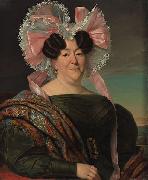 |
Jan Adam Kruseman
|
|
Petrus Augustus de Genestet (P.A. de Genestet) (Amsterdam, November 21, 1829 - Rozendaal, July 2, 1861) was a Dutch poet and a theologian.
Petrus Augustus de Genestet lost both of his parents at a very young age; after that he lived with his uncle, the Dutch painter Jan Adam Kruseman. He studied at the Amsterdamse Atheneum and the Seminarium der Remonstrantse Broederschap to become a preacher. He became minister in March of 1852 at the Genestetkerk (Genestetchurch) that was named after him, in Delft. In the same year he got married to Henriette Bienfait in Bloemendaal. They had two children. In 1859, he lost both his wife and oldest child died of tubercolosis, and because of his poor health he had to quit working as a minister. He moved to Amsterdam, but spent most of his summers in Bloemendaal. Two years later, in 1861, he died in Rozendaal.
|
|
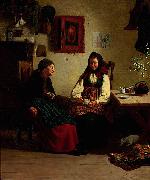 |
Jakob Kulle
|
|
painted Allmogeinterior med kaffedrickande kvinnor in 1876
|
|
 |
Jacob Koninck
|
|
(c. 1615, Amsterdam - c. 1695, Copenhagen), was a Dutch Golden Age landscape painter.
According to Houbraken he lent his books on perspective to Johannes Verkolje, who became better than he was at perspective drawing.He was a disciple of Adriaen van de Velde who became a popular painter in Copenhagen where he painted for the court of Christian V of Denmark.
According to the RKD he was the uncle of Salomon Koninck, a pupil of David Colijns and became the teacher of his son Jacob II and his younger brother Philips Koninck.He was in Dordrecht from 1633-1636, Rotterdam from 1637-1645, The Hague from 1647-1651, back in Amsterdam in 1658 (when he probably lent young Verkolje his perspective books), and moved to Denmark in 1676.
|
|
 |
Jacob Knyff
|
|
(January 1, 1639, Haarlem - 1681, London), was a Dutch Golden Age painter.
According to Houbraken he was the teacher of Johannes Gottlieb Glauber in Paris in 1671, where he attended the funeral of Nicolaes Berchem II on January 4, 1672. he was probably the son of the painter Wouter Knijff, and is known for painting landscapes and seascapes
|
|
|
|
|
|
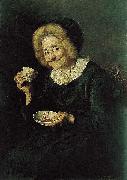 |
Ivana Kobilca
|
|
Ivana Kobilca (20 December 1861 - 4 December 1926) was a Slovene realist painter who lived, worked and studied in various European cities including Vienna, Sarajevo, Berlin, Paris and Munich. She was a member of Societe Nationale des Beaux Arts in Paris. Many of her paintings are still lifes, portraits or country settings. She later tended toward impressionism.
Her best known paintings are Kofetarica (Coffeemadam), 1888; Citrarica (The Zitherist), Likarice (Women Ironers), 1891; Holandsko dekle (A Dutch Girl), Portret sestre Fani (Portrait of Sister Fani), 1889; and Poletje (Summer), 1889.
|
|
|
|
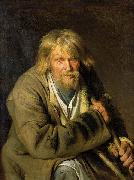 |
Ivan Nikolaevich Kramskoi
|
|
(June 8 (O.S. May 27), 1837 ?C April 6 (O.S. March 24), 1887; was a Russian painter and art critic. He was an intellectual leader of the Russian democratic art movement in 1860-1880.
Kramskoi came from a poor petty-bourgeois family. From 1857 to 1863 he studied at the St. Petersburg Academy of Arts; he reacted against academic art and was an initiator of the "revolt of fourteen" which ended with the expulsion from the Academy of a group of its graduates, who organized the Artel of Artists
Influenced by the ideas of the Russian revolutionary democrats, Kramskoi asserted the high public duty of the artist, principles of realism, and the moral substance and nationality of art. He became one of the main founders and ideologists of the Company of Itinerant Art Exhibitions (or Peredvizhniki). In 1863-1868 he taught at the drawing school of a society for the promotion of applied arts. He created a gallery of portraits of important Russian writers, scientists, artists and public figures (Lev Nikolaevich Tolstoy, 1873, Ivan Shishkin, 1873, Pavel Mikhailovich Tretyakov, 1876, Mikhail Saltykov-Shchedrin, 1879, Sergei Botkin, 1880) in which expressive simplicity of composition and clarity of depiction emphasize profound psychological elements of character. Kramskoi's democratic ideals found their brightest expression in his portraits of peasants, which portrayed a wealth of character-details in representatives of the common people.
In one of Kramskoi's most well known paintings, Christ in the Desert (1872, Tretyakov gallery), he continued Alexander Ivanov's humanistic tradition by treating a religious subject in moral Cphilosophical terms. He imbued his image of Christ with dramatic experiences in a deeply psychological and vital interpretation, evoking the idea of his heroic self-sacrifice.
Aspiring to expand the ideological expressiveness of his images, Kramskoi created art that existed on the cusp of portraiture and genre-painting ("Nekrasov during the period of 'Last songs,'" 1877-C78; "Unknown Woman," 1883; "Inconsolable grief," 1884; all in Tretyakov gallery). These paintings disclose their subjects' complex and sincere emotions, their personalities and fates. The democratic orientation of Kramskoi's art, his acute critical judgments about it, and his persistent quest for objective public criteria for the evaluation of art exerted an essential influence on the development of democratic art and aesthetics in Russia in the last third of the nineteenth century.
|
|
 |
Ivan Kramskoi
|
|
(June 8 (O.S. May 27), 1837 C April 6 (O.S. March 24), 1887)
|
|
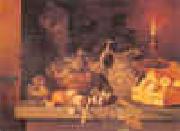 |
Ivan Khrutsky
|
|
1810-1885 Russian Ivan Khrutsky Gallery was a Russian-Polish painter known by his still-lives and portraits. He was born Ivan Fomich Khrutsky into a family descended from Polish gentry in the village of Ula, Vitebsk Gubernia (currently Belarus). In 1827, Khrutsky came to St. Petersburg and in 1830 entered the Imperial Academy of Arts. His first known works are dated 1832. The paintings gradually gathered public and critical acclaim. Khrutsky also worked as an interior designer, and became a popular amongst the wealthy home owners. In 1836, Khrutsky was awarded the Major Silver medal of the Academy for his still-lifes. Khrutsky also executed nice genre pictures and portraits. Old Woman Knitting a Sock, brought him the Minor Gold medal of the Academy. In 1839 he was awarded the title of the Academician. After his father??s death in 1840 Khrutsky left St. Petersburg forever and settled in the family estate Zakharenichi (Zacharniczy), Polotsk region. This period was one of commissioned religious art, mostly from Lithuania. Besides religious paintings he also worked on portraits, such as I.I. Glazunov's, Joseph Semashko's, Mikolaj Malinowski's and others. He died in 1885.
|
|
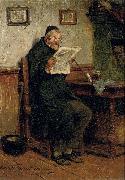 |
Hugo Wilhelm Kauffmann
|
|
(7 August 1844 - 30 December 1915) was a German painter, the son of Hermann Kauffmann.
Kauffmann was born in Hamburg. In 1861 he went to Frankfurt and worked there under Jakob Becker, Edward Jakob von Steinle and Johann Nepomuk Zwerger. From 1863-71 he lived in Kronberg in the Taunus. During this time he spent one winter in Hamburg and a five-month period in Desseldorf too; afterwards he spent 1½ years in Paris, until 1870 when the war drove him out. He lived until 1871 in Munich. He died in Prien at the Chiemsee in 1915.
|
|
|
|
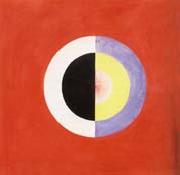 |
Hilma af Klint
|
|
1862 - 1944,was a Swedish artist and mystic whose paintings were amongst the first abstract art. She belonged to a group called 'The Five' and the paintings or diagrams were a visual representation of complex philosophical ideas. The fourth child of Captain Victor af Klint, a Swedish naval commander, and Mathilda af Klint (n??e Sonntag), Hilma af Klint spent summers with her family at their farm Hammora on the island of Adelsö in Lake Mälaren. In these idylic surroundings Hilma came into contact with nature at an early stage in her life and this deep association with natural forms was to be an inspiration in her work. From her father she adopted an interest in mathematics. In 1880 her younger sister Hermina died and it was at this time that the spiritual dimension of her life began to develop. She showed an early ability in visual art and after the family had moved to Stockholm she studied at the Academy of Fine Arts for five years during which time she learned portraiture and landscape painting . Here she met Anna Cassel, the first of the four women with whom she later worked in 'The Five' (de fem), a group of artists who shared her ideas. Her more conventional painting became the source of her financial income while the 'life's work' remained a quite separate practice.
|
|
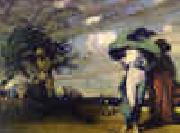 |
Henry Keller
|
|
1870-1949
Henry Keller Gallery
Henry George Keller (1869 - 1949) was an American artist who led a generation of Ohio watercolor painters of the Cleveland School. Keller's students at the Cleveland School of Art and his Berlin Heights, Ohio summer school included Charles E. Burchfield, Paul Travis, and Frank N. Wilcox.
|
|
|
|
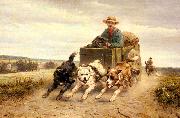 |
Henriette Ronner-Knip
|
|
was a Dutch painter.
Born Henriëtte Knip in Amsterdam, she moved at a young age to Den Bosch and was until 1850 active in Sint-Michielsgestel and Boxtel. That year she married Feico Ronner and moved to Belgium, first to Brussels and in 1878 to Elsene. She studied with her father, Joseph August Knip.
She was best known for her paintings of subjects from nature, especially cats and dogs.
|
|
|
|
|
|
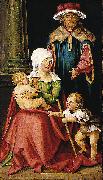 |
Hans von Kulmbach
|
|
(real name Hans Suess or Hans Seß) was born around 1480 in Kulmbach, Franconia and died previous to Dec. 3, 1522 in Nuremberg. Hans von Kulmbach was the artist who created the Krakew St. John's Altar.
Kulmbach probably arrived in Nuremberg around 1505. He received instruction by Jacopo de' Barbari, who for a time worked in Nuremberg. Von Kulmbach then apprenticed with Albrecht Derer and after Derer retired from painting altarpieces in 1510 Kulmbach took over most of his commissions. Kulmbach had his own workshop in Nuremberg and at times worked in Krakew. He also created artworks for emperor Maximilian I and for Margrave Casimir Hohenzollern von Brandenburg-Kulmbach. His best works were stained-glass windows in churches, such as the Maximilian stained-glass, Margrave stained-glass at St. Sebald in Nuremberg, the Welser stained-glass at the Frauenkirche and the Nikolaus altar at Lorenzkirche. In 1511 he finished the St. Mary's altar at Skałka in Krakew. The Catherine and St. John's altar also in Krakew, are among his best works.
|
|
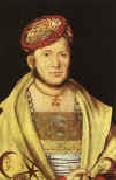 |
Hans Suss von Kulmbach
|
|
1476-1522
German
Hans Suss von Kulmbach Gallery
German painter and graphic artist. His real name was Hans S??ss. In general his work reveals the influence of D??rer, but he had little of the master's power. Von Kulmbach worked chiefly in Nuremberg, although he probably spent several years in Cracow as court painter. His masterpiece is the Tucher altarpiece for the Church of St. Sebald in Nuremberg. He also executed portraits and designs for painted glass.
|
|
|
|
|
|
|
|
|
| Wholesale China Oil Painting Wholesale Oil Painting China Xiamen Portrait Reproduction on canvas Chinese Oil Painting Wholesale USA Oil Painting |
|
|
|
|
|